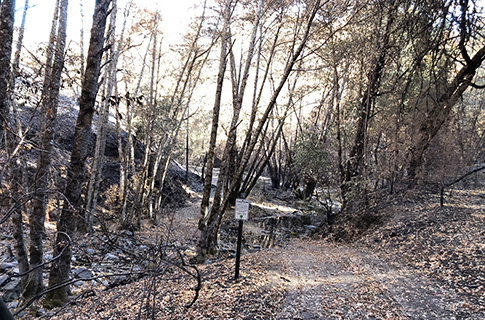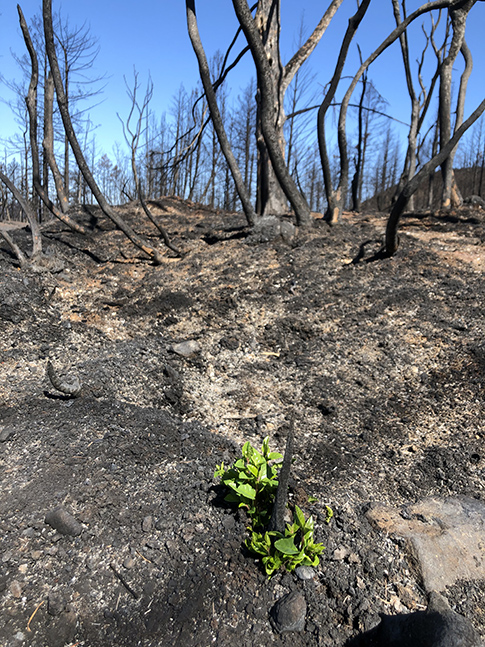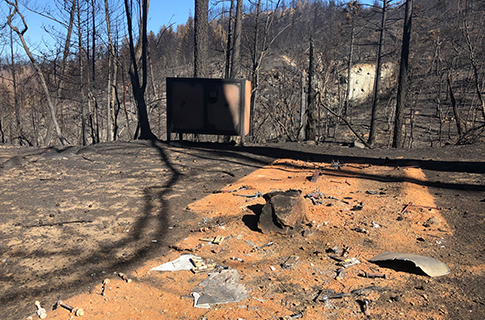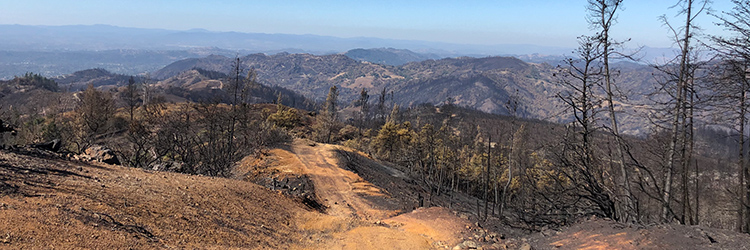How is Hood Mountain Regional Park faring after the Glass Fire?
Second major wildfire in three years does damage, but nature will rebound
By Sarah Phelps
Hood Mountain Regional Park and Open Space Preserve was in the direct path of the Glass Fire on Sept. 28, 2020 when the fire topped the Mayacamas Mountains from Napa County, driven by dry conditions and strong winds on its way toward Eastern Santa Rosa.
Overall, the wildfire burned approximately 80 percent of the 2,000-acre park. About 50 percent was a moderate- to high-severity burn that killed or heavily damaged many trees. Since early October, our field crews have been felling hazard trees and clearing access roads and trails.
Unlike the 2017 Nuns Fire that burned Hood Mountain's southern side near the Pythian Road entrance, the Glass Fire burned the hottest and did the most damage to the northern side of Hood Mountain near the Los Alamos Road entrance. The fire burned the interior of the park, from the Santa Rosa Creek headwaters through the Sargent cypress forest, past the Hood Mountain summit and into Sugarloaf Ridge State Park.

The Hood Mountain Trail crossing over Santa Rosa creek, heading toward the Los Alamos Road parking lot.
More damage to trees
In contrast to the damage in 2017, we’re seeing a higher number of severely damaged trees, in part due to the fact that trees that burned three years ago were far more susceptible to wildfire this time around. Several high-wind events and red flag warnings over the past two months have slowed our progress clearing trees and other fire debris from service roads and trails. Some roads and trails still have not been cleared, and we don’t yet know when we can safely reopen the park.
Over the winter, we will continue to assess the damage and prioritize recovery steps. Top of mind is addressing potential erosion risks, like replacing damaged retaining walls on trails and roads, ahead of the rainy season.
Nature heals
However, in nature there is always a silver lining. Just as we witnessed after the Nuns Fire, wildlife have returned to the park and blackened trees are beginning to show signs of new life.
This montage of videos taken by one of our wildlife cameras show flames from the Glass Fire moving quickly across the Valley View Trail on the evening of Sept. 28. However, mere hours after the embers and smoke have cleared, a jackrabbit is seen hopping along the same trail. The following days and weeks provide a glimpse of a variety of wildlife using the same trail. (Make sure to turn your sound on and you'll also hear birds returning to the trees.)
Even in the most devastated parts of the park, we are seeing the potential for the natural world to spring back to life. The trails are still here, and will be visible once vegetation comes back this spring. We are losing many fir trees, but that gives slow-growing oaks the chance to compete for more sunlight. The fire damage may be hard to look at, but we must remember these habitats are adapted to fire, and in many cases, flames benefit our native plants and animals.

Green shoots, looking very much alive, were already sprouting in early November.
Steps to reopening
To return the park to a safe place for public recreation, it is the man-made infrastructure – the burned signs, trails markers, picnic tables, wooden steps, retaining walls – that need our attention and resources now.

All that’s left of Azalea Creek Campground is the metal bear box.
The Sonoma County Parks Foundation hosts a Fire Recovery and Resilience Fund that will help Hood Mountain come back from this damage. Donations can be directed to the Hood Mountain Fire Recovery Campaign of the Bill and Dave Legacy Fund. Hood Mountain Regional Park has always been revered for its beauty, in a wild, harsh kind of way… and that still holds true for Hood Mountain post-wildfire.
Sarah Phelps is a marketing specialist at Sonoma County Regional Parks.



 Translate
Translate